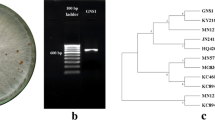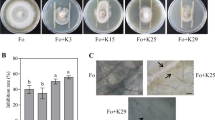Abstract
Background and aims
Co-inoculation of biocontrol agents with different modes of action is assumed to improve biocontrol activity. The present study aimed to investigate the effects of single or co-inoculation of Trichoderma viride strain GB7 and Serratia plymuthica strain 3Re4-18 on microbial communities in the rhizosphere of lettuce and their ability to suppress Rhizoctonia solani AG1-IB.
Methods
Growth chamber experiments with two different application modes were performed with single or co-inoculation of GB7 and 3Re4-18 in the presence or absence of R. solani. Biocontrol efficacy and plant growth parameters were assessed. Bacterial and fungal communities were analyzed by 16S rRNA gene and ITS fragments PCR-amplified from total community DNA of rhizosphere samples and analyzed by denaturing gradient gel electrophoresis.
Results
Compared to the single application, the co-inoculation of 3Re4-18 and GB7 resulted in an improved biocontrol efficacy. DGGE analysis revealed more pronounced effect on microbial community in co-inoculation treatment. The abundance of 3Re4-18 in the rhizosphere seemed to be increased in the presence of R. solani.
Conclusions
The applied cultivation-independent methods provided insights into the complex interaction in response to the pathogen and the antagonists. Co-inoculation resulted in an improved biocontrol efficacy and an increased evenness of the microbial communities.




Similar content being viewed by others
References
Abeysinghe S (2009) Effect of combined use of Bacillus subtilis CA32 and Trichoderma harzianum RU01 on biological control of Rhizoctonia solani on Solanum melongena and Capsicum annuum. Plant Pathol J 8:9–16
Adesina MF, Grosch R, Lembke A, Vatchev TD, Smalla K (2009) In vitro antagonists of Rhizoctonia solani tested on lettuce: rhizosphere competence, biocontrol efficiency and rhizosphere microbial community response. FEMS Microbiol Ecol 69:67–74
Berg G, Krechel A, Ditz M, Faupel A, Ulrich A, Hallmann J (2005) Endophytic and ectophytic potato-associated bacterial communities differ in structure and antagonistic function against plant pathogenic fungi. FEMS Microbiol Ecol 51:215–229
Blancard D, Lot H, Maisonneuve (2006) A color atlas of disease of lettuce and related salad crops: observation, biology and control. Elsevier, London
Brewer MT, Larkin RP (2005) Efficacy of several potential biocontrol organisms against Rhizoctonia solani on potato. Crop Protect 24:939–950
Chellemi DO (2002) Nonchemical management of soilborne pests in fresh market vegetable production systems. Phytopathology 92:1367–1372
De Curtis F, Lima G, Vitullo D, De Cicco V (2010) Biocontrol of Rhizoctonia solani and Sclerotium rolfsii on tomato by delivering antagonistic bacteria through a drip irrigation system. Crop Prot 29:663–670
De Vleesschauwer D, Chernin L, Höfte MM (2009) Differential effectiveness of Serratia plymuthica IC1270-induced systemic resistance against hemibiotrophic and necrotrophic leaf pathogens in rice. BMC Plant Biol 9:9
Faltin F, Lottmann J, Grosch R, Berg G (2004) Strategy to select and assess antagonistic bacteria for biological control of Rhizoctonia solani Kühn. Can J Microbiol 50:811–820
Felici C, Vettori L, Giraldi E, Forino LMC, Toffanin A, Tagliasacchi AM, Nuti M (2008) Single and co-inoculation of Bacillus subtilis and Azospirillum brasilense on Lycopersicon esculentum: effects on plant growth and rhizosphere microbial community. Appl Soil Ecol 40:260–270
González-García V, Portal Onco MA, Rubio Susan V (2006) Review. Biology and Systematics of the form genus Rhizoctonia. Span J Agric Res 4:55–79
Götz M, Gomes NCM, Dratwinski A, Costa R, Berg G, Peixoto R, Mendonça-Hagler L, Smalla K (2006) Survival of gfp-tagged antagonistic bacteria in the rhizosphere of tomato plants and their effects on the indigenous bacterial community. FEMS Microbiol Ecol 56:207–218
Gravel V, Martinez C, Antoun H, Tweddell RJ (2005) Antagonist microorganisms with the ability to control Pythium damping-off tomato seeds in rockwool. BioControl 50:771–786
Grosch R, Faltin F, Lottmann J, Kofoet A, Berg G (2005) Effectiveness of 3 antagonistic bacterial isolates to control Rhizoctonia solani Kühn on lettuce and potato. Can J Microbiol 51:345–353
Grosch R, Koch T, Kofoet A (2006) Signum, ein neues Fungizid zur Bekämpfung der Salatfäule: Sicher gegen Rhizoctonia solani an Salat. Gemüse 42:14–16
Grosch R, Rehn VNC, Rehn KG, Mendonça-Hagler L, Smalla K, Lottmann J, Berg G (2007) Analysis of antagonistic interactions between Trichoderma isolates from Brazilian weeds and the soil-borne pathogen Rhizoctonia solani. J Plant Dis Protect 114:167–175
Haas D, Défago G (2005) Biological control of soil-borne pathogens by fluorescent pseudomonads. Nature Rev Microbiol 3:307–319
Haichar FZ, Achouak W, Christen R, Heulin T, Marol Ch, Marais MF, Mougel Ch, Ranjard L, Balesdent J, Berge O (2007) Identification of cellulolytic bacteria in soil by stable isotope probing. Env Microbiol 9:625–634
Herschkovitz Y, Lerner A, Davidov Y, Rothballer M, Harmann A, Okon Y, Jurkevitch E (2005) Inoculation with the plant-growth-promoting rhizobacterium Azospirillum brasilense causes little disturbance in the rhizosphere and rhizoplane of maize (Zea mays). Microb Ecol 50:277–288
Heuer H, Krsek M, Baker P, Smalla K, Wellington EMH (1997) Analysis of actinomycete communities by specific amplification of genes encoding 16S rRNA and gel electrophoretic separation in denaturing gradients. Appl Environ Microbiol 63:3233–3241
Heuer H, Wieland G, Schönfeld J, Schönwälder A, Gomes NCM, Smalla K (2001) In: Rouchelle P (ed) Bacterial community profiling using DGGE or TGGE analysis. Environmental molecular microbiology: protocols and applications. Horizon Scientific Press, Wymondham, UK, pp 177–190
Kozdroj J, Trevors JT, van Elsas JD (2004) Influence of introduced biocontrol agents on maize seedling growth and bacterial community structure in the rhizosphere. Soil Biol Biochem 36:1775–1784
Lahlali R, Hijri M (2010) Screening, identification and evaluation of potential biocontrol fungal endophytes against Rhizoctonia solani AG3 on potato plants. FEMS Microbial Letters 311:152–159
Lugtenberg B, Kamilova F (2009) Plant-growth-promoting rhizobacteria. Annu Rev Microbiol 63:541–556
Marimuthu S, Subbian P, Ramamoorthy V, Samiyappan R (2002) Synergistic effect of combined application of Azospirillum and Pseudomonas fluorescens with inorganic fertilizer on root rot incidence and yield of cotton. J Plant Dis Protect 109:569–577
Martin FN (2003) Development of alternative strategies for management of soilborne pathogens currently controlled with methyl bromide. Ann Review Phytopathol 41:325–350
Meyer SLF, Roberts DP (2002) Combinations of biocontrol agents for management of plant-parasitic nematodes and soilborne plant-pathogenic fungi. J Nematol 34:1–8
Michelsen CF, Stougaard P (2011) A novel antifungal Pseudomonas fluorescens isolated from potato soils in Greenland. Curr Microbiol 62:1185–1192
Müller H, Westendorf C, Leitner E, Chernin L, Riedel K, Schmidt S, Eberl L, Berg G (2009) Quorum-sensing effects in the antagonistic rhizosphere bacterium Serratia plymuthica HRO-C48. FEMS Microbiol Ecol 67:468–478
Pierson EA, Weller DM (1994) Use of mixtures of fluorescent pseudomonads to suppress take-all and improve the growth of wheat. Phytopathology 84:940–947
Raaijmakers JM, Weller DM (2001) Exploiting genotypic diversity of 2,4-diacetylphloroglucinol-producing Pseudomonas spp.: characterization of superior root-colonizing P. fluorescens strain Q8r1-96. Appl Environ Microbiol 67:2545–2554
Raupach GS, Kloepper JW (1998) Mixtures of plant growth-promoting rhizobacteria enhance biological control of multiple cucumber pathogens. Biol Control 88:1158–1164
Roberts DP, Lohrke SM, Meyer SLF, Buyer JS, Bowers JH, Baker CJ, Li W, de Souza JT, Lewis JA, Chung S (2005) Biocontrol agents applied individually and in combination for suppression of soilborne diseases of cucumber. Crop Prot 24:141–155
Robinson-Boyer L, Jeger MJ, Xu XM, Jeffries P (2009) Management of strawberry grey mold using mixtures of biocontrol agents with different mechanisms of action. Biocontrol Sci Techn 19:1051–1065
Scher FM, Ziegle JS, Kloepper JW (1994) A method for assessing the root-colonizing capacity of bacteria on maize. Can J Microbiol 30:151–157
Scherwinski K, Wolf A, Berg G (2007) Assessing the risk of biological control agents on the indigenous microbial communities: Serratia plymuthica HRO-C48 and Streptomyces sp. HRO-71 as model bacteria. BioControl 52:87–112
Schisler DA, Slininger PJ, Bothast RJ (1997) Effects of antagonist cell concentration and two-strain mixtures on biological control of Fusarium dry rot of potatoes. Phytopathology 87:177–183
Schmidt CS, Agostini F, Simon AM, Whyte J, Townend J, Lifert C, Killham K, Mullins C (2004) Influence of soil type and pH on the colonization of sugar beet seedlings by antagonistic Pseudomonas and Bacillus strains, and on their control of Pythium damping-off. Eur J Plant Pathol 110:1025–1046
Van den Boogert PHJF, Luttikholt AJG (2004) Compatible biological and chemical control systems for Rhizoctonia solani in potato. Eur J Pl Pathol 110:111–118
Vargas Gil S, Meriles J, Conforto C, Basanta M, Radl V, Hagn A, Schloter M, March GJ (2011) Response of soil microbial communities to different management practices in surface soils of a soybean agroecosystem in Argentina. Eur J Soil Biol 47:55–60
Vestberg M, Kukkonen S, Saari K, Prikka P, Huttunen J, Tainio L, Devos N, Weekers F, Kevers C, Thonart P, Lemoine MC, Cordier C, Alabouvette C, Gianinazzi S (2004) Microbial inoculation for improving the growth and health of micropropagated strawberry. Appl Soil Ecol 27:243–258
Weinert N, Meincke R, Gottwald C, Heuer H, Gomes NC, Schloter M et al (2009) Rhizosphere communities of genetically modified zeaxanthin-accumulating potato plants and their parent cultivar differ less than those of different potato cultivars. Appl Environ Microbiol 75:3859–3865
Wilson P, Ahvenniemi P, Lehtonen M (2008) Biological and chemical control and their combined use to control different stages of the Rhizoctonia disease complex on potato through the growing season. Ann Appl Biol 153:307–320
Xu XM, Robinson J, Jeger M, Jeffries P (2010) Using combinations of biocontrol agents to control Botrytis cinerea on strawberry leaves under fluctuating temperatures. Biocontrol Sci Techn 4:359–373
Zachow Ch, Fatehi J, Cardinale M, Tilcher R, Berg G (2010) Strain-specific colonization pattern of Rhizoctonia antagonists in the root system of sugar beet. FEMS Microbiol Ecol 74:124–135
Acknowledgements
The authors acknowledge the bilateral project between Brazil and Germany funded by the BMBF BRA 05/021 and the DFG SM59/11-1/GR568121. We would also like to thank Angelika Fandrey for her skilled technical assistance and Christin Zachow for her helpful comments.
Author information
Authors and Affiliations
Corresponding author
Additional information
Responsible Editor: Bernard Glick.
Rights and permissions
About this article
Cite this article
Grosch, R., Dealtry, S., Schreiter, S. et al. Biocontrol of Rhizoctonia solani: complex interaction of biocontrol strains, pathogen and indigenous microbial community in the rhizosphere of lettuce shown by molecular methods. Plant Soil 361, 343–357 (2012). https://doi.org/10.1007/s11104-012-1239-y
Received:
Accepted:
Published:
Issue Date:
DOI: https://doi.org/10.1007/s11104-012-1239-y




